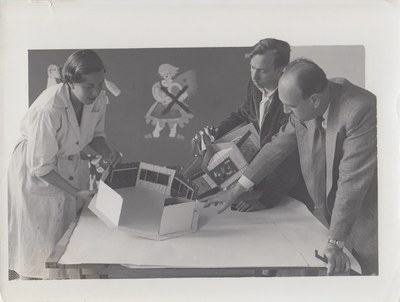M.A. Jonas Kühne
- Name
- M.A. Jonas Kühne
- jonas.kuehne (at) hu-berlin.de
Vita
Jonas Kühne studied History and Political Science at Dresden University of Technology and Leipzig University. He organized and participated at the workshop “Museums and Material Cultures: Exhibiting the GDR” in 2010. Together with other students of Leipzig University and Loyola Marymount University (Los Angeles, USA) he developed the digital exhibition “What is a Socialist City?” for the Wende Museum in Culver City. He finished his graduate studies in History with a thesis examining the U.S. exhibition program of the Office of Military Government in Germany after WWII. From 2013 to 2015 Jonas Kühne was working at Kommission für Geschichte des Parlamentarismus und der politischen Parteien (Commission for the History of Parliamentarism and of Political Parties) as a scientific assistant. This preliminary work was funded by the Humboldt Research Track Scholarship. Since June 2018 the Studienstiftung des deutschen Volkes (German Academic Scholarship Foundation) is granting a scholarship for the research project.
Jonas Kühne is an associate member at the research college "Exhibiting Knowledge | Knowledge in Exhibitions" at Georg-Albrecht-University Göttingen.
Research Interests
- Exhibition Studies
- Cold War Cultures
- Transnational History
Research Project
Promoting the West. The Expositions of the US Exhibition Section in Germany, 1945-1960
 This research project studies the American exhibition program in Germany after World War II. It examines the expositions of the US Exhibition Section between 1945 and 1960. Despite their diversity in form, content and visual appearance they served a common objective. They facilitated orientation and activation of the German audience in favor of a capitalist consumer society. They, on the other hand intended to integrate the Federal Republic of Germany into the community of values of the transatlantic West during the early Cold War period.
This research project studies the American exhibition program in Germany after World War II. It examines the expositions of the US Exhibition Section between 1945 and 1960. Despite their diversity in form, content and visual appearance they served a common objective. They facilitated orientation and activation of the German audience in favor of a capitalist consumer society. They, on the other hand intended to integrate the Federal Republic of Germany into the community of values of the transatlantic West during the early Cold War period.
The study is focusing on three main points. First, the US Exhibition Section is described as a transnational curatorial organization, which neither had the purpose of collecting and presenting like a museum nor was it a part of performing or visual arts. For a better understanding of this kind of expositional work this section will look into the organizational history, the transatlantic actor network as well as the production conditions under which the exhibitions were put on display.
Secondly six illustrative exhibition ensembles will be examined at the level of design, content and reception: the traveling exhibition program in the American Information Centers (1947-49), the Marshall Plan exhibitions (1950-52), the Berlin based expositions “ATOM” (1954), “Kleider machen Leute” (1955) and “Unbegrenzter Raum” (1956), and the trade fair booth on US agriculture at IKOFA in Munich (1958).
The exhibition analyses shall thirdly help to answer the following questions: How did the political environment of the Cold War shape the exhibitions? Against this background, how did the West and East German audience perceive them? Which influences of the history of exhibitions before 1945 are reflected in the examined expositions? How did they adapt and refine preceding curatorial experiences? How did the US Exhibition Section shape the subsequent development of exhibiting in West Germany?
Picture credit: US Exhibition Section staff members with models of an agricultural exhibition, ca. 1947/48, Nuremberg, Germany. Estate Claus-Peter Groß, photographic collection Kunstbibliothek, SMB.
Publications
- Review of: Roos, Julia: Ausstellungen als öffentliches Ärgernis?. Die bundesdeutsche Museumskontroverse der 1970er-Jahre um das Präsentieren von Vergangenheiten. Berlin 2018, in: H-Soz-Kult, 18.06.2021 [www.hsozkult.de/publicationreview/id/reb-28014].
-
"'A simple straight-forward story.' Fotomontagen in der Marshallplan-Ausstellung 1950 in Berlin, in: Ziehe, Irene/Hägele, Ulrich (Hg.): Populäre Präsentationen. Fotografie und Film als Medien musealer Aneignungsprozesse (Visuelle Kultur. Studien und Materialien, Bd. 13), Münster 2019, pp. 101-120.
- 1871 – Fragen an die deutsche Geschichte (1971), in: te Heesen, Anke/Schulze, Mario/Dold, Vincent (ed.): Museumskrise und Ausstellungserfolg. Die Entwicklung der Geschichtsausstellung in den Siebzigern, Berlin 2015, p. 18-33 (together with Tobias von Borcke und Aya Zarfati).
